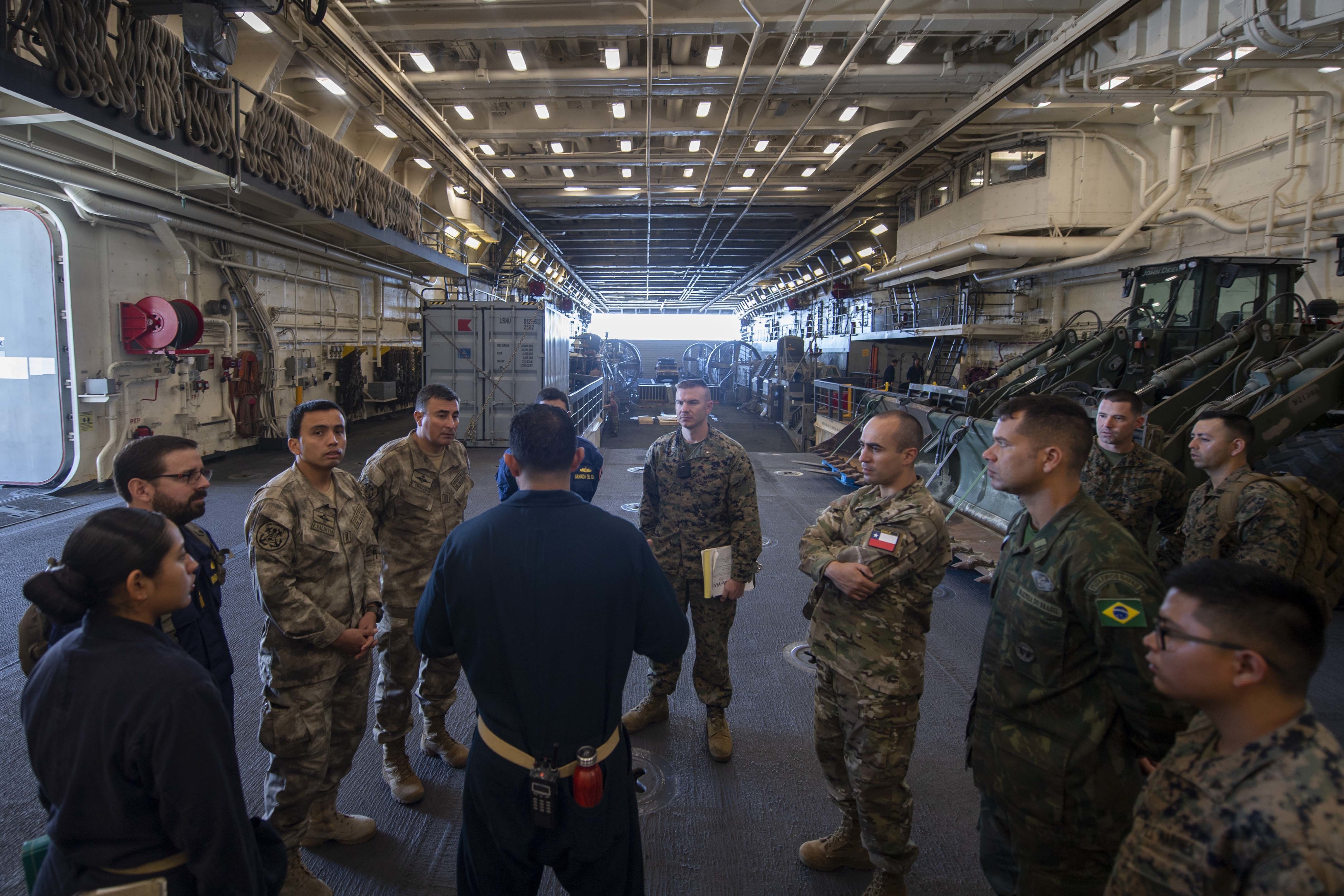
The Navy deployed a new ship pairing – a destroyer (DDG-51) and an amphibious transport dock (LPD-17) – to test out a new concept that could supplement amphibious squadrons and surface action groups as a formation in future operations.
USS Somerset (LPD-25), USS Wayne E. Meyer (DDG-108) and Special Purpose Marine Air-Ground Task Force (SP-MAGTF)-Peru deployed together as Littoral Combat Group 1 in November and December.
While at sea, the operations the group conducted leveraged both ships’ bread and butter missions: supporting Marines and pushing them ashore, embarking a Coast Guard law enforcement detachment, hosting a surgical team for humanitarian assistance work, and more. The two ships sailed to Valparaiso, Chile, for the Eleventh International Maritime and Naval Exhibition and Conference for Latin America (EXPONAVAL) and the 200th anniversary of the Chilean Navy. Also during the deployment, the 1,000 sailors and Marines from LCG-1 worked with the Peruvian Naval Infantry in a humanitarian assistance and disaster relief exercise in the disaster-prone Chorrillos district outside Lima, and conducted a maritime patrol exercise with Ecuadorian navy assets to counter illegal, unregulated and unreported (IUU) fishing, among other activities.

The goal of the LCG-1 deployment was to work out the command and control, which placed a Navy captain as the commodore of two ships and the SP-MAGTF, as is the case with the commodore of an amphibious squadron (PHIBRON) who oversees an Amphibious Ready Group and Marine Expeditionary Unit, or a destroyer squadron commander (DESRON) commanding a surface action group. Still, though the focus of the deployment was on command and control and not the actual missions that a DDG and an LPD could conduct together, it’s easy to see how the Littoral Combat Group could be useful higher up the range of military operations: the DDG firing missiles at an enemy defense system to allow the Marine forces to move ashore, the Marines using their MV-22B aircraft in support of the DDG’s maritime security missions at sea, and so on.
A Navy official told USNI News that Expeditionary Strike Group 3 was the lead on this experimental deployment and will present the command structure and lessons learned to higher headquarters for review. The ESG, which reports to U.S. 3rd Fleet and includes PHIBRON 3, helped organize the disparate ships, leaders and detachments in just three weeks, pulling staff from 28 different commands. LCG-1 was led by Capt. Ken Coleman, the PHIBRON 3 commodore, and included a staff of 30 to 35 on temporary assignment and embarked on Somerset.

“The deployment of LCG-1 was designed to test a command and control concept. Wayne E. Meyer and Somerset were scheduled to participate in EXPONAVAL based on their operational schedules at the time, and LCG-1 provided command and control of those assets under a single commander. The complementary capabilities (brought by the) assigned Navy and Marine Corps units will inform future force development, both in how we organize our naval forces and how we employ them,” 3rd Fleet told USNI News in a written statement.
“In addition to its participation in EXPONAVAL, LCG-1 conducted several partnership training missions while underway and ashore in the [U.S. Southern Command area of responsibility.]”
LCG-1 reported directly to U.S. 3rd Fleet and U.S. 4th Fleet during the deployment, much like a PHIBRON would. Upon returning home – Somerset is homeported in San Diego and Wayne E. Meyer is now homeported in Pearl Harbor – the command disestablished. ESG-3 will take lessons learned from the deployment and make a proposal up the chain of command regarding how, if at all, this construct could be applied going forward, the Navy official said.

The Navy and Marine Corps are revising their concepts to align with the National Defense Strategy that focuses on warfare against a peer or near-peer adversary. Whereas previous concepts relied on conventional carrier strike groups and amphibious ready groups to sail into waters uncontested and conduct their operations, newer concepts coming out look at fleet-wide coordination of disaggregated forces that can oppose an adversary in blue-water operations or in the littorals. Both the Navy and Marine Corps are pursuing new anti-ship capabilities for submarines, surface ships and ground forces, and the two services are looking at new ways the Marines can support the battle for sea control from ashore in the same way the Navy can support forces on the ground from at sea. Two key concepts, Distributed Maritime Operations and Littoral Operations in a Contested Environment, are being fleshed out now and will inform upcoming acquisition and exercise efforts in the coming years.





